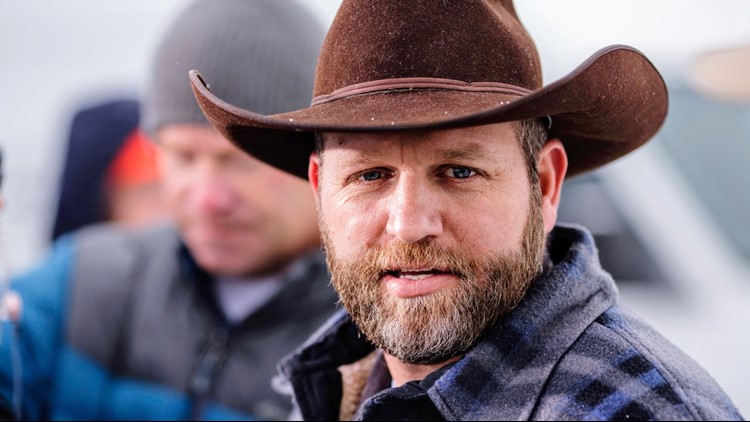PORTLAND, Ore. — Ammon Bundy, who was recently acquitted in the armed occupation of a national wildlife refuge in Oregon, testified Tuesday that he felt "driven" to protest federal control of Western lands after learning that two Oregon ranchers were imprisoned for setting fires on public rangeland.
Bundy was brought to the federal courtroom in Portland from Las Vegas, where he is in custody awaiting trial on charges he led armed gunmen to block a federal cattle roundup near his father's Nevada ranch in 2014.
A defense attorney for Bundy's fellow occupier Jason Patrick of Bonaire, Georgia, walked Bundy through the series of events that led him and others to seize the Malheur National Wildlife Refuge on Jan. 2, 2016. Bundy, his brother Ryan and five others were acquitted in the Oregon case last fall.
Duane Ehmer of Irrigon, Oregon; Darryl Thorn of Marysville, Washington; and Jake Ryan of Plains, Montana, are also being retried.
In response to questions from defense attorney Andrew Kohlmetz, Bundy said that the seeds for the refuge takeover were planted in October 2015, when he first heard about Dwight and Steven Hammond, two ranchers from rural Oregon who were about to report to prison for a five-year sentence after being convicted of setting fires on public rangeland.
it was like I was pushed out of that bed and I needed to learn more. I felt driven and I don't know how to quite explain it. ... I felt a drive, an urge, to find out all I can and to get myself familiar with what was going on. -- Ammon Bundy on how he became interested in case of Dwight and Steven Hammond
He was lying in bed when he read an article about their case and "when I read that article, it was like I was pushed out of that bed and I needed to learn more," he said. "I felt driven and I don't know how to quite explain it. ...I felt a drive, an urge, to find out all I can and to get myself familiar with what was going on."
He spent all night reading about the case online, wrote a blog post and wrote a letter that was eventually sent to 28,000 people by e-mail, he testified.
Shackled and wearing a blue prison outfit, Bundy testified that he identified with the Oregon ranchers because he felt his own family had been targeted in a similar fashion by federal Bureau of Land Management agents who were trying to seize his father's cattle in a decades-long dispute over grazing rules and unpaid fees.
In April 2014, Bundy backers pointed weapons at BLM agents and contract cowboys who were rounding up cattle near the Bundy ranch outside Bunkerville, Nevada, according to federal prosecutors. Bundy, his brother Ryan and his father, Cliven, are all scheduled for trial later this year on charges including conspiracy, firearms offenses and assault of a federal officer in the Nevada standoff.
"My conclusion was what was happening to them was very similar to what had happened to my family," Bundy said of the Hammonds.
He decided to drive to Burns, Oregon from his home in Idaho because he wanted to learn "why families like ours and the Hammonds ... are in the situation we're in where we're losing our heritage," he said.
My conclusion was what was happening to them was very similar to what had happened to my family. (I wanted to learn) why families like our and the Hammonds ... are in the situation we're in where we're losing our heritage. -- Ammon Bundy on the connection he felt to the Hammond case
Bundy met with the Hammonds and also with the Harney County sheriff in the hopes he would "bring light and stand for the Hammonds" by pushing back against federal authorities and convening a county-run investigation, he said.
Harney County Sheriff Dave Ward testified during Bundy's trial last year that he met with Bundy four times but ultimately disagreed that it was his role to intervene on behalf of the Hammonds. He felt Bundy was making ultimatums and warned him that the community wouldn't tolerate the kind of actions Bundy's family had taken at the Nevada ranch, he has said.
The Bundys were arrested in a Jan. 26 traffic stop away from the refuge that ended with police fatally shooting Robert "LaVoy" Finicum, an occupation spokesman. Most occupiers left the refuge after Finicum's death, but a few holdouts remained until Feb. 11, 2016.
The acquittal of the Bundy brothers and the five others in what had seemed to be an open-and-shut case was a stunning blow for federal prosecutors last October.
Like the defendants in the first trial, the primary charge facing the men is conspiracy to impede Interior Department employees from doing their jobs at the refuge through the use of force, threats or intimidation.
This time, prosecutors hired an outside consultant to help them with jury selection and hedged their bets by adding misdemeanors such as trespassing to the mix of charges against the four men. The misdemeanor charges will be heard in a non-jury trial after the felony trial ends.
Follow Gillian Flaccus on Twitter at http://www.twitter.com/gflaccus



